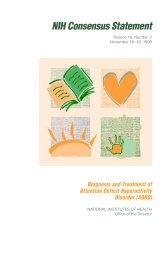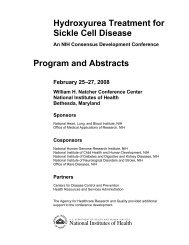Celiac Disease - NIH Consensus Development Program - National ...
Celiac Disease - NIH Consensus Development Program - National ...
Celiac Disease - NIH Consensus Development Program - National ...
Create successful ePaper yourself
Turn your PDF publications into a flip-book with our unique Google optimized e-Paper software.
Should Children Be Screened for <strong>Celiac</strong> <strong>Disease</strong>? Is There Evidence To Support the Strategy of Screening All Children? Edward J. Hoffenberg, M.D.The identification of accurate serologic markers for celiac disease (CD) provides a tool tostudy at-risk groups as well as whole populations. Although the ability to conduct widespreadscreening is evident, the wisdom of such an endeavor needs evaluation.How should the question of screening children be evaluated? Guides published30–40 years ago provide a framework still relevant today for CD screening. (1,2) Adapting fromthese sources, eight criteria relevant to screening children for CD merit consideration.Important Health Problem: Serious, PrevalentThe prevalence of CD approaches 0.5–1 percent of the U.S. general population. (3,4) Mostcases have no or mild symptoms and are identifiable only by screening. Whether all forms of CDhave the same long-term consequences (i.e., osteoporosis, intestinal malignancy) has not beendetermined. Whether screening-identified CD represents a “serious” problem similar to that ofclinically identified CD requires further study.Diagnostic Criteria Accepted and Widely AvailableThe “ESPGN criteria” developed for the clinical diagnosis of CD requires characteristichistologic findings on small bowel biopsy plus a response to therapy with a strict gluten-free diet.This response may be improvement of symptoms or of intestinal injury. (5) Problems with thisdefinition include patchiness of intestinal injury; expertise in histologic interpretation;assumption of compliance with a strict gluten-free diet; subjectivity in the assessment ofsymptomatic improvement (and specific to screening-identified CD, absence of symptoms); andpoor acceptance of followup biopsy.Diagnostic criteria which incorporate autoantibody assays need updating. To address thisneed, algorithms for the evaluation of screening- and clinically-identified CD have recently beendeveloped and will need validation and acceptance. (6)Screening Tests Available, Acceptable, Reliable, and ValidThe antitransglutaminase antibody screening test (TG) is widely available. In the clinicalsetting, TG has a sensitivity of 95–100 percent for biopsy confirmation of CD. But in screeningat-risk populations, the predictive value lingers around 75 percent. (7) It is unknown whetherbiopsy negative cases represent false-positive TG results, false-negative biopsy results, milddisease (celiac autoimmunity without villous atrophy), or early “latent” CD. The significantvariability among commercial tests is also an issue. Cutoffs, usually derived using well79







